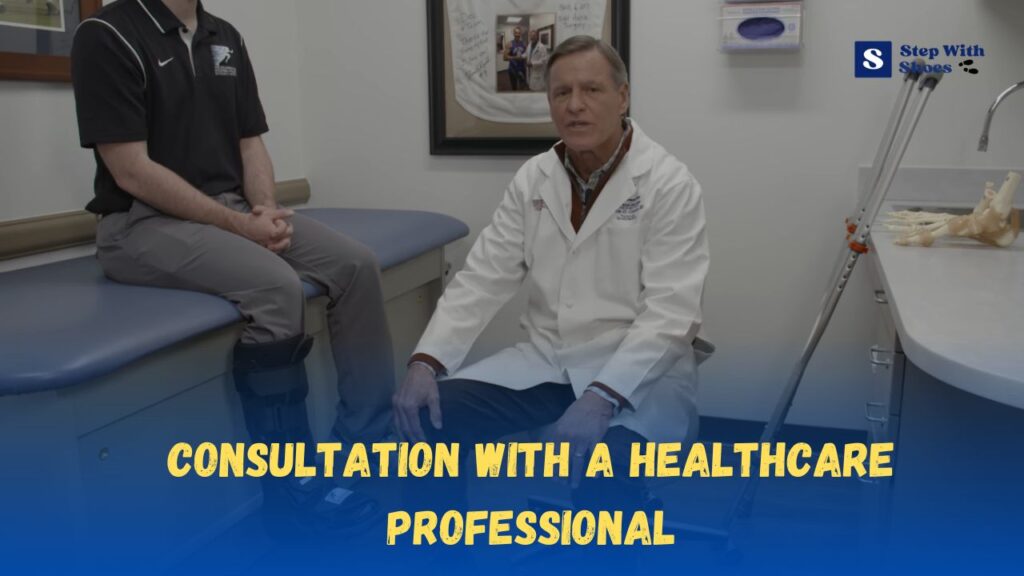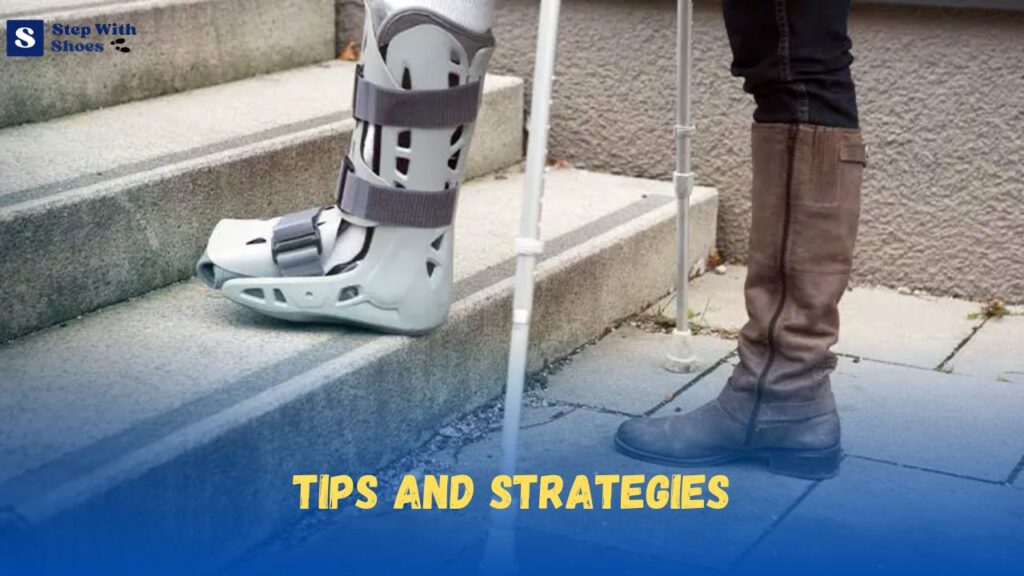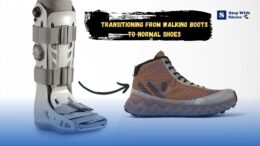Transitioning from a walking boot to a normal shoe requires a gradual adjustment to prevent re-injury and promote proper healing. We will discuss the steps you can take to safely transition from wearing a walking boot to a regular shoe, as well as tips to ensure a smooth recovery process.
By following these guidelines, you will be able to regain full mobility and comfortably return to your regular activities. Let’s dive in and explore how you can make the transition from a walking boot to a normal shoe as smooth as possible.
Transitioning From A Walking Boot
Transitioning from a walking boot to a normal shoe requires a gradual approach. Going too quickly can lead to discomfort and potential re-injury. Factors to consider before transitioning include the extent of the injury, the healing progress, and the recommendation of your healthcare professional.
Physical therapy is crucial in this process, as it helps strengthen the affected muscles and joints, improving stability and preventing further injuries. By gradually reducing the use of the walking boot and increasing the time spent in a regular shoe, you allow your body to adjust and adapt to the change.
Following the guidance of your healthcare provider and engaging in regular physical therapy sessions will ensure a smooth transition and minimize the risk of setbacks. Listen to your body and take it slow to achieve a successful and comfortable transition.
The Importance of a Gradual Transition
Why Rushing the Transition is Risky
- Rushing the transition can lead to a higher risk of re-injury, as the injured area may not have fully healed or regained its strength.
- Abrupt movements or undue pressure can exacerbate the damage, leading to persistent discomfort, pain, and swelling.
- Your body might struggle to adapt to the new demands, affecting your gait and posture.
- Frustration and anxiety from a rushed transition can have a negative impact on your mental and emotional well-being.
Benefits of a Gradual Transition
- A gradual transition reduces re-injury risk, allowing the injured area to regain strength, flexibility, and stability.
- It promotes better long-term outcomes, improving comfort and stability while boosting confidence.
- A gradual approach is more physically and mentally comfortable, minimizing pain and offering a sense of control.
Potential Consequences of Skipping Steps
- Skipping steps in the transition process can lead to increased pain, swelling, and fatigue.
- It may cause problems in other parts of your body due to a breakdown in overall biomechanics.
- Skipping crucial steps can increase the risk of falls and accidents due to an unadjusted sense of balance.
In summary, following a gradual transition is essential to ensure a safe and successful return to your normal footwear while avoiding potential pitfalls associated with rushing or skipping steps.
transition plans, and guide you through a safe and effective recovery process. Finding the right healthcare provider is crucial to ensure a smooth and successful transition.
Consultation with a Healthcare Professional

The Role of a Doctor or Physical Therapist
Doctors and physical therapists play pivotal roles in ensuring a smooth transition from a walking boot to a regular shoe. Their expertise is essential in guiding patients through this process effectively. Doctors, such as orthopedic specialists or surgeons, bring valuable medical insight to the transition. They conduct thorough evaluations of your injury or surgery, often utilizing diagnostic tests like X-rays to determine the state of your healing. It is this evaluation that provides the green light to begin transitioning, ensuring that your bones have healed adequately and that complications have been addressed.
Physical therapists, on the other hand, bring specialized knowledge in musculoskeletal health and movement. They are crucial in helping patients regain strength, flexibility, and proper movement patterns. Their involvement is particularly important for a well-rounded recovery because they craft personalized rehabilitation plans, taking into account the nature of your injury or surgery and your current physical condition. These plans often include targeted exercises and activities aimed at strengthening the affected area and improving balance and mobility. They also incorporate milestones and checkpoints to assess your progress, ensuring that you transition safely and effectively.
Customized Transition Plans
One of the most significant benefits of consulting with a healthcare professional is the creation of a customized transition plan. These plans are tailored to your unique circumstances, addressing factors such as age, overall health, the nature of your injury or surgery, and your level of physical activity. These individualized plans involve a gradual reduction in the use of the walking boot and the gradual introduction of regular shoes.
Customized transition plans also include specific exercises and activities that cater to your unique needs. These activities aim to strengthen the affected area and enhance your balance and mobility. Milestones and checkpoints are strategically placed within the plan to evaluate your progress continually. The goal of these customized transition plans is to optimize your recovery and minimize the risk of complications, allowing you to safely return to your regular activities without setbacks or re-injury. The benefit of a tailored plan cannot be understated; it accounts for your specific needs and ensures that the transition is as smooth and successful as possible.
How to Find a Healthcare Professional
Finding the right healthcare professional is essential for a successful transition. If you’re uncertain about how to locate a healthcare provider for your needs, here are some steps to consider. Start by consulting your primary care physician; they often have valuable recommendations and can provide referrals to specialists such as orthopedic surgeons or physical therapists. In many cases, your surgeon or hospital may also refer you to a specific physical therapist for post-surgery care.
Another avenue to explore is seeking recommendations from friends, family, or acquaintances who may have had similar experiences. Personal referrals can provide valuable insights into the quality of care you can expect. Online resources and reviews can also assist you in finding a healthcare provider with a good reputation. Ensure that the professional you choose has expertise in your specific condition and makes you feel comfortable and well-informed. A strong patient-provider relationship is crucial during your recovery, as open communication and trust contribute to the overall success of the transition process.
Preparing For The Transition
Transitioning from a walking boot to a normal shoe can be a significant milestone in your recovery process. Understanding the healing process is crucial for a successful transition. Assess your pain and mobility to determine if you are ready for the change.
Discussing with your healthcare provider is essential to ensure that it is the right time for you. Remember to follow their advice and recommendations closely. By preparing for the transition, you can increase your chances of a smooth and comfortable progression towards wearing a normal shoe again.
Take it step by step, listen to your body, and be patient with yourself throughout this transition. Soon enough, you will be back to your normal routine and feeling confident in your regular footwear.
Stage 1: Introducing Supportive Shoe Wear
Transitioning from a walking boot to a normal shoe involves several stages. In stage 1, it is important to introduce supportive shoewear. Choosing the right shoes is crucial for proper healing and comfort. Incorporating supportive insoles can further provide stability and reduce discomfort.
It is recommended to gradually increase the duration of wearing these shoes, starting with short periods and gradually extending them. This allows the foot to adapt and strengthens the muscles. The transition process should be carried out under the guidance of a healthcare professional to ensure a successful and safe recovery.
By following these steps, one can smoothly transition from a walking boot to a normal shoe without any complications.
Stage 2: Gradual Weight-Bearing
After completing stage 1 of wearing a walking boot, it’s time to move on to stage 2: gradual weight-bearing. This transition period involves using assistive devices, like crutches or a cane, to support your weight. Practicing partial weight-bearing will help gradually increase strength and stability in your injured leg.
It’s important to monitor any pain or swelling during this process, as it can be a sign of overexertion. By following these guidelines and being patient with yourself, you can successfully make the transition from a walking boot to a normal shoe, and resume your regular activities.
Remember to consult with your healthcare provider for personalized advice and a customized plan that suits your specific needs.
Stage 3: Full Weight-Bearing
Transitioning from a walking boot to a normal shoe involves reaching stage three: full weight-bearing. During this phase, it is crucial to monitor progress closely. Gradually increasing activity levels helps the foot adjust to bearing weight again. Additionally, incorporating balance exercises can enhance stability and support.
It is important to stay committed to the recovery process and follow recommended guidelines. By doing so, individuals can successfully transition from a walking boot to wearing a normal shoe again, enjoying renewed mobility and freedom.
Stage 4: Strengthening And Conditioning
Transitioning from a walking boot to a normal shoe is a crucial stage in the recovery process. Strengthening and conditioning play a vital role in this stage. The importance of ankle and foot exercises cannot be overstated. These exercises not only help in building strength but also enhance overall conditioning.
To ensure effective rehabilitation, it is essential to follow certain guidelines. These guidelines include avoiding overused words and phrases, keeping sentences brief, and writing in an seo friendly and unique manner. Varying the phrases at the beginning of paragraphs will keep the reader engaged.
Remember, no need for a conclusion paragraph. So, let’s focus on providing comprehensive and useful information on transitioning from a walking boot to a normal shoe
Tips and Strategies

Actionable Tips for Readers
Actionable tips provide readers with practical advice they can implement during their transition from a walking boot to a normal shoe. These tips are designed to make the process smoother and safer.
One actionable tip is to stick to your healthcare professional’s guidance. Following your doctor’s or physical therapist’s recommendations is crucial. They have tailored your transition plan to your unique needs, so adhering to their instructions helps ensure a successful transition. It’s also essential to gradually increase your weight-bearing on the injured limb. Don’t rush into full weight-bearing with a regular shoe; take it slow to avoid overloading the healing area. Wearing a supportive brace or shoe can provide extra stability as you transition.
Additionally, consider foot and ankle exercises to improve strength and flexibility. Gentle range-of-motion exercises and stretching can help prevent stiffness and improve mobility. Monitor your pain and discomfort levels carefully during the transition. It’s normal to experience some discomfort, but severe or increasing pain can be a sign of an issue that should be addressed promptly.
Strategies for Implementing the Topic
Effective strategies are key to implementing the transition successfully. These strategies include developing a plan and setting realistic goals.
One strategy is to set gradual milestones for yourself. These can be as simple as increasing the time you spend walking in regular shoes each day. It’s essential to track your progress. Keep a diary or use a mobile app to record how you feel, your pain levels, and your activity increases. This data can help you and your healthcare professional make adjustments as needed.
Wearing appropriate footwear is a critical strategy. Choose shoes that provide adequate support and cushioning, especially during the initial stages of the transition. Consult with your healthcare provider or a shoe specialist to find the right footwear for your needs. Another strategy is to modify your environment to reduce the risk of accidents. Ensure your home is free of hazards, such as loose rugs or clutter, and use handrails for support when necessary.
How to Overcome Challenges
Challenges are an inevitable part of any transition process, and overcoming them is essential for a successful outcome.
When facing challenges, consider seeking emotional support and encouragement from family, friends, or support groups. Sharing your experiences and concerns with others who have gone through similar transitions can provide valuable insight and motivation. Managing your expectations is another key strategy. Understand that setbacks can occur, and it’s essential not to become discouraged if you face hurdles along the way.
Regular communication with your healthcare provider is vital in overcoming challenges. If you encounter difficulties or have questions, don’t hesitate to reach out for guidance. They can provide insights and make adjustments to your plan as necessary. Lastly, maintain a positive mindset. The power of a positive attitude should not be underestimated. Staying focused on your goals and recognizing your progress, no matter how small can help you overcome challenges and stay motivated throughout the transition process.
Monitoring Progress And Adjusting
Transitioning from a walking boot to a normal shoe requires monitoring progress and adjusting accordingly. It is crucial to recognize warning signs, such as persistent pain or discomfort. If these signs persist, seeking professional advice is recommended. Additionally, adjusting the transitioning plan as necessary is important for a successful recovery.
Regular check-ins with a healthcare professional can ensure that the transition is going smoothly. By following these guidelines, you can ensure a seamless transition from a walking boot to a normal shoe, enabling you to regain your mobility and independence.
Frequently Asked Questions On Transition From Walking Boot To Normal Shoe
How Long Does It Take To Transition From A Walking Boot To A Normal Shoe?
It typically takes about 4-6 weeks to transition from a walking boot to a normal shoe. However, the exact duration may vary depending on individual circumstances and the severity of the injury. It is important to follow your healthcare provider’s instructions and gradually increase the amount of time you spend wearing a normal shoe.
Can I Start Wearing Normal Shoes Immediately After Removing The Walking Boot?
It is not recommended to start wearing a normal shoe immediately after removing the walking boot. Your foot and ankle need time to adjust and regain strength, flexibility, and stability. It is advisable to start by wearing a supportive shoe with good cushioning and gradually increase the time spent wearing it.
What Exercises Can I Do To Help With The Transition From A Walking Boot To A Normal Shoe?
Some exercises that can help with the transition include ankle stretches, toe curls, heel raises, and balance exercises. These exercises can help improve strength, flexibility, and stability in your foot and ankle, ultimately aiding in the transition to a normal shoe.
It is important to consult with your healthcare provider or a physical therapist to determine the best exercises for your specific situation.
Conclusion
Making the transition from a walking boot to a normal shoe is an important step in the recovery process. By gradually reintroducing the foot to regular footwear, you can regain confidence and mobility. It’s essential to pay attention to any discomfort or pain during the process, as it may be an indication that you need to slow down and give your foot more time to adjust.
A gradual transition, starting with shorter periods of time in regular shoes and gradually increasing, is recommended. Additionally, incorporating exercises to strengthen the foot and ankle muscles can help improve stability and prevent future injuries. Remember to listen to your body and consult with your healthcare provider if you have any concerns.
With patience and proper rehabilitation, you can successfully transition from a walking boot to a normal shoe and return to your regular activities.



